Fiend Without A Face, 1958, directed by Arthur Crabtree, screenplay by Herbert J. Leder, from the short story "The Thought Monster" by Amelia Reynolds Long.
Some movies are brilliant from the first frame to the last. Some are irredeemable drek all the way through. And some have flashes of greatness. Fiend Without A Face falls into the last category, although it's not so much a flash as a splatter.

That's one of the eponymous fiends, the physical manifestation of a human thought, in its death throes. Yes, in this movie, human thoughts are represented as giant brains with attached prehensile spinal columns. With eyes on stalks. When shot, vast quantities of raspberry jam squirt out of them with horrible burbling noises. They eat brains. They're powered by atomic radiation. And they can fly. More or less what Pascal wrote about in Pensées, if I remember it correctly.
As awesome as flying, brain-eating brains sound (and they are pretty awesome), the fiends don't actually appear for the first hour of the movie. So the audience has to wade through the obligatory "mysterious string of deaths in a small town" section to get to the good stuff. The first hour has its compensations: a pre-Doktari Marshall Thompson is very, very serious in uniform:

And Kim Parker, as Thompson's love interest, does what she can to help with the marketing campaign:

That shower scene is completely gratuitous and not very risqué, but it was featured in every advertisement and poster for the film. So if you don't get to see women's legs or shoulders in your day-to-day life, Fiend Without A Face has that going for it. But there's only so much narrative interest you can squeeze out of a whodunnit where Kynaston Reeves' character is clearly, obviously, a mad scientist.

People address him as "Professor Walgate," though he doesn't teach! He does that fist-clenching thing that only mad scientists do! No one in town understands his research! Worst of all, he's written prop books: the ominously titled The Energy of Thought and the ominously spelled Sibonetics: The Application of Logic To Electronics.

The misspelled title, the peeling label on the spine, the fact that the spine of Sibonetics has embossed printing everywhere but the title: all of this screams "crackpot." The local citizenry can't believe one of their own could be behind the mysterious disappearances, especially when there's a more obvious scapegoat: nearby Stock Footage Air Force Base, pictured below:
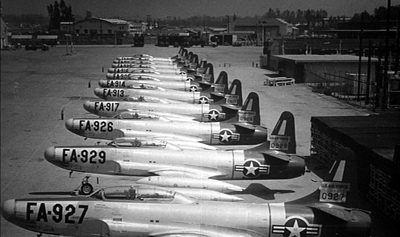
They appear to be about as well-staffed as Professor Walgate's publisher; this is the most personnel in any shot, during a test of an experimental radar system:

It's worth noting that there are more personnel here than there are at the nuclear plant that powers the base:
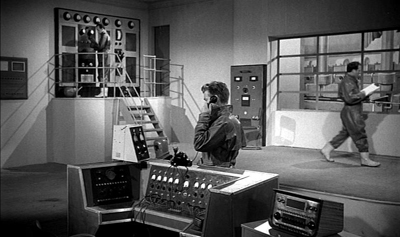
What's more, apparently radar stations and nuclear plants are controlled with the same equipment, an early example of modular design. Note that although you need four more telephones to control a radar test, the consoles are otherwise identical.
Nobody sees a movie like Fiend Without a Face for the set design or snappy dialogue, though, and within the realm of B-sci-fi/horror, this is a fun little movie. It's certainly better than The Blob, even without Steve McQueen. Crabtree knows how to shoot suspense, especially in the sequences where the fiends are still invisible. They move around with a distinctive thumping, slurping sound that is surprisingly creepy. There are decent "stuck in the house alone with the monster" sequences (especially the mayor's death). And as on-the-nose as much of the dialogue is, it's hard not to love a film that introduces us to the main character by showing him smoking and popping pills at his desk, while his subordinate asks him, "You ever think of trying sleep instead of Benzedrine? You know, you might like it."

So, yeah, there's some goofy charm here. But the movie's not famous for goofy charm, and it would have long faded into B-movie obscurity were it not for the over-the-top gross-out fest that is the final fifteen minutes. Actually, it would probably have been famous even without the special effects, because without the "locked in a house frantically boarding up windows while countless horrors try to get in" sequence, we would not have had The Birds or Night of the Living Dead.
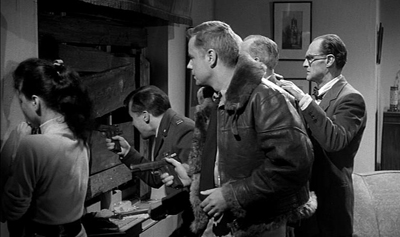
On the other hand, without Fiend Without A Face, we might have all been spared Gore-Met, Zombie Chef From Hell and basically any other schlock horror that ignores the uncanny in favor of the abject. Because:

And furthermore:
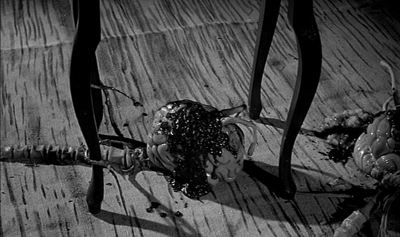
The fiends' deaths aren't just grosser than anything that came before, they're grosser than just about anything that came after, at least until Cronenberg. No, the stop-motion animation isn't very convincing, and yes, they're kind of silly looking to begin with, but there's something about the burbling noise they make as the goop squirts out of them that's completely stomach turning. Inducing nausea isn't enough to make a movie great (look at Salò), and this isn't a great movie. But even a cursory glance at the horror and sci-fi that followed it will show that, for better and for worse, Fiend Without A Face has cast a much longer shadow than your typical Z-grade horror. For a movie made for almost nothing by a producer whose greatest goal was to build England's answer to American International Pictures, that counts as an extraordinary success.
Randoms:
- I wasn't kidding about England's answer to American International. Producer Richard Gordon's brother Alex worked at American International and literally plucked "The Thought Monster" from their pile of rejected submissions.
- The best dialogue in the film is not the Benzedrine line, believe it or not. It's when Professor Walgate announces, "We're facing a new form of life that nobody understands. I believe it feeds no the radiation from your atomic plant, and that it's evil."
- The highly-trained professionals at the Air Force base know exactly what to do when they discover that the fiends feed on atomic radiation. Like anyone with a great deal of experience with nuclear energy would, they put as much TNT as they can find in the control room and blow the whole building up. As the scientists in the audience know, destroying the cooling system and control rods for a controlled nuclear reaction causes the whole thing to gracefully shut itself down, with no long term effects on the surrounding area.
- You can learn an awful lot about budget filmmaking from studying this movie closely, both from the missteps (like the control console noted above) and the successes. Crabtree stages his nuclear plant explosion by showing a static shot of the "plant":
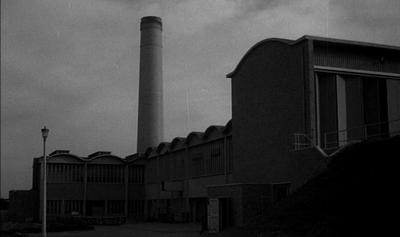
- He follows this by flickering a few single-frame inserts of all white:

- And then cuts to stock footage of a model exploding that is clearly not the same building, if you look at the first frames of it going up:
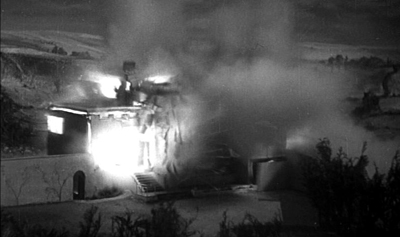
- But since the "building" is obliterated in just a few frames, and the flying debris that follows could be from just about anything:

- The effect viewed at normal speed isn't half-bad. And must have cost approximatelly nothing. Which is a long way of saying I'm planning on using a lot of footage from Roland Emmerich movies in anything I do going forward.
- MGM distributed Fiend Without A Face domestically, as a double feature with another John Croyden/Richard Gordon production, The Haunted Strangler (also in the Criterion Collection). It had a very nice run at the Rialto on Times Square:
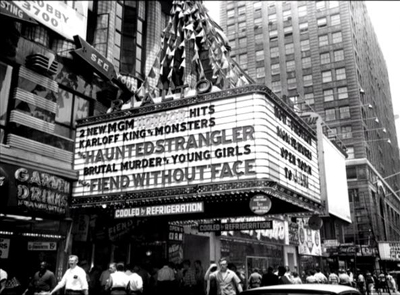
- In 1958, it was the place to show horror films in New York City, complete with Arclight-style lobby exhibits on the sidewalk itself:

- That's the right kind of theater for Fiend Without A Face, but it's not where it premiered. The geniuses at MGM sent it for a tryout, along with The Haunted Strangler, to Detroit's Adams Theater, which was MGM's prestige house in the area. Before Fiend, it was showing Gigi, and the theater manager was less than enthused with Richard Croydon's suggestion that they promote the upcoming films by setting up a coffin with a body in it in the lobby. Things didn't go well for the theater after that; it was finally demolished just this summer, but didn't age gracefully. It did a stint as a porn theater, tried unsucessfully to go back to legitimate movies, but was finally sunk when it was the site of a homocide and a shootout (separate incidents!) in 1988. Here's the auditorium circa 2005. Which just goes to show: no good will come of inadequately promoting a Karloff picture.
- No good will come of adequately promoting a Karloff picture either; the Rialto was torn down in 1998 to make way for the Reuters building. It did its time as an adult theater too; its last incarnation was for one of those hydraulic seat attractions called Cinema 3-D. So maybe the best thing is not to have anything to do with Karloff pictures at all.

